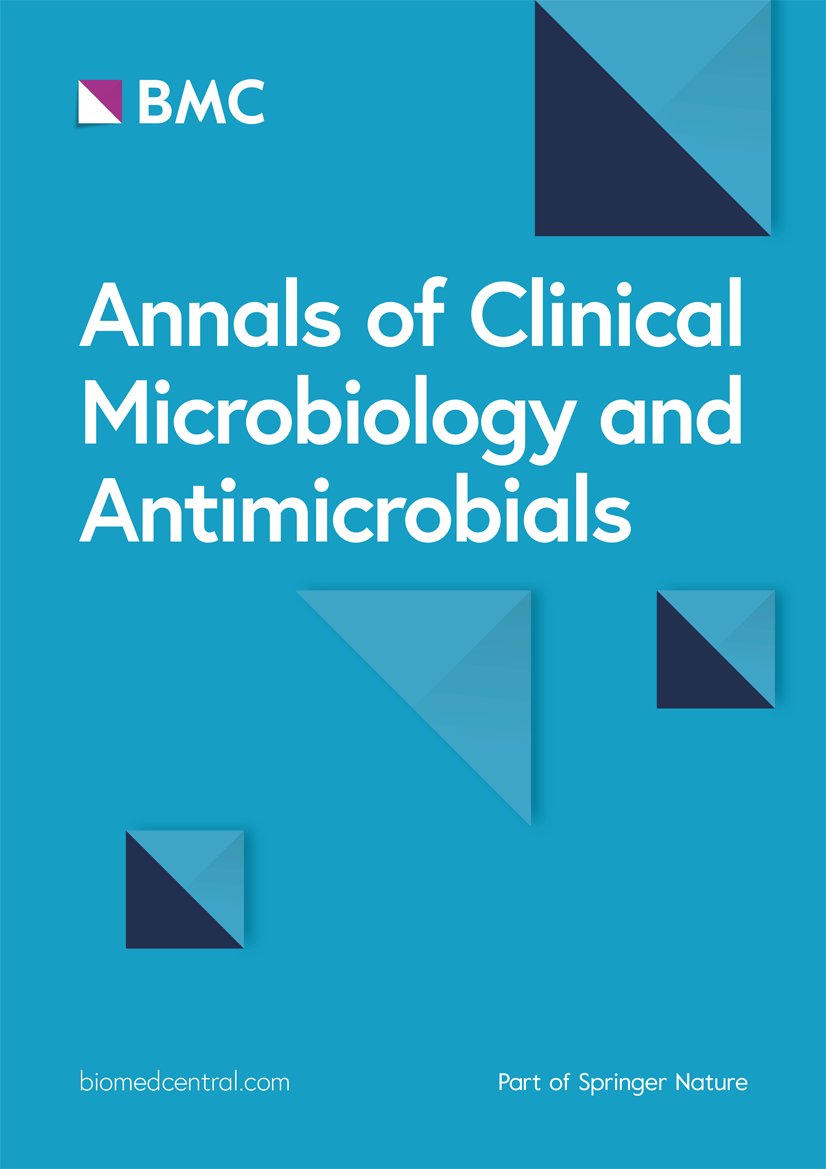肺孢子虫和疱疹病毒共同感染:一项为期七年的回顾性研究
IF 4.6
2区 医学
Q1 MICROBIOLOGY
Annals of Clinical Microbiology and Antimicrobials
Pub Date : 2024-01-20
DOI:10.1186/s12941-023-00663-2
引用次数: 0
摘要
吉罗韦氏肺孢子菌(P. jirovecii)是一种机会性真菌,在免疫力极度低下的患者中可引起肺孢子菌肺炎(PCP),在轻度免疫抑制或呼吸功能受损的患者中可引起肺定植。五氯苯酚和巨细胞病毒(CMV)合并感染的病例已被广泛报道,而涉及其他疱疹病毒(HVs),如爱泼斯坦-巴尔病毒(EBV)、单纯疱疹病毒 1 型和 2 型(HSV-1 和 -2)以及水痘带状疱疹病毒(VZV)的病例仍然很少。迄今为止,还没有关于 P. jirovecii 定殖中 HVs 合并感染的数据。我们的主要目的是评估支气管肺泡灌洗液(BALF)样本中 HVs 在五氯苯酚患者或肺定植患者中的频率。次要目标是评估 HVs 与五氯苯酚患者死亡率之间的关系。这是一项为期七年的单中心回顾性研究。所有在 BALF 样本中使用 PCR 检测到 P. jirovecii 的患者,以及使用 PCR 检测 HVs 的患者均被纳入研究范围。研究共纳入了 125 名患者,其中 77 人为 PCP 患者,48 人为定植患者。在 54/77 例(70.1%)五氯苯酚患者和 28/48 例(58.3%)定植患者中至少检测到一种 HV。两组患者中最常见的都是 EBV。此外,与 EBV 合并感染、[EBV + HSV-1]合并感染和无 HV 合并感染相比,[EBV + CMV] 合并感染的 PCP 患者的 30 天存活率明显较低。我们的结果表明,HV 单独或合并感染在 PCP 和定植中的频率相似。这些结果还表明,在五氯苯酚患者的 BALF 样本中检测到[EBV + CMV]与死亡率升高有关,这也说明了在五氯苯酚病程中检测 HV 的重要性。本文章由计算机程序翻译,如有差异,请以英文原文为准。
Pulmonary co-infections by Pneumocystis jirovecii and Herpesviridae: a seven-year retrospective study
Pneumocystis jirovecii (P. jirovecii) is an opportunistic fungus responsible for Pneumocystis pneumonia (PCP) in deeply immunocompromised patients and for pulmonary colonization in individuals with mild immunosuppression or impaired respiratory function. PCP and Cytomegalovirus (CMV) co-infections have been widely described whereas those involving other Herpesviruses (HVs) such as Epstein-Barr virus (EBV), Herpes simplex virus type 1 and type 2 (HSV-1 and -2), and Varicella zoster virus (VZV) remain scarce. To date, no data are available concerning HVs co-infections in P. jirovecii colonization. Our main objective was to evaluate the frequency of HVs in bronchoalveolar lavage fluid (BALF) samples from patients with PCP or with pulmonary colonization. The secondary objective was to assess the relationship between HVs and the mortality rate in PCP patients. A retrospective single-center study over a seven-year period was conducted. All patients with P. jirovecii detected using PCR in a BALF sample and for whom a PCR assay for HVs detection was performed were included in the study. One hundred and twenty-five patients were included, corresponding to 77 patients with PCP and 48 colonized patients. At least one HV was detected in 54/77 (70.1%) PCP patients and in 28/48 (58.3%) colonized patients. EBV was the most frequent in both groups. Furthermore, the 30-day survival rate in PCP patients was significantly lower with [EBV + CMV] co-infection than that with EBV co-infection, [EBV + HSV-1] co-infection and without HV co-infection. Our results show that the frequency of HV, alone or in combination is similar in PCP and colonization. They also suggest that [EBV + CMV] detection in BALF samples from PCP patients is associated with an increased mortality rate, underlying the significance to detect HVs in the course of PCP.
求助全文
通过发布文献求助,成功后即可免费获取论文全文。
去求助
来源期刊

Annals of Clinical Microbiology and Antimicrobials
MICROBIOLOGY-
CiteScore
8.60
自引率
0.00%
发文量
49
审稿时长
>12 weeks
期刊介绍:
Annals of Clinical Microbiology and Antimicrobials considers good quality, novel and international research of more than regional relevance. Research must include epidemiological and/or clinical information about isolates, and the journal covers the clinical microbiology of bacteria, viruses and fungi, as well as antimicrobial treatment of infectious diseases.
Annals of Clinical Microbiology and Antimicrobials is an open access, peer-reviewed journal focusing on information concerning clinical microbiology, infectious diseases and antimicrobials. The management of infectious disease is dependent on correct diagnosis and appropriate antimicrobial treatment, and with this in mind, the journal aims to improve the communication between laboratory and clinical science in the field of clinical microbiology and antimicrobial treatment. Furthermore, the journal has no restrictions on space or access; this ensures that the journal can reach the widest possible audience.
 求助内容:
求助内容: 应助结果提醒方式:
应助结果提醒方式:


